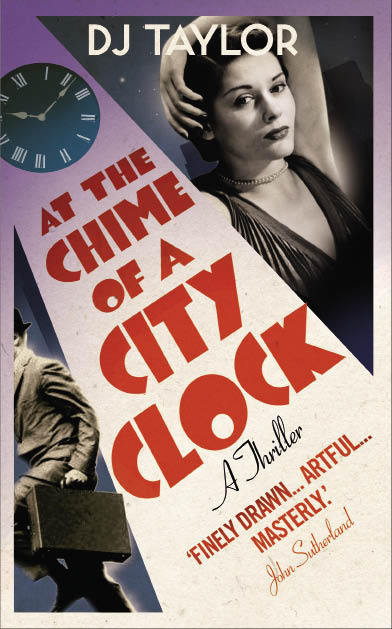The strange, unsettled decades between the wars form the backdrop of much of D. J. Taylor’s recent work, including his novel, Ask Alice, and his social history, Bright Young Things. At the Chime of a City Clock is set in 1931, with a financial crisis rumbling in the background.
The strange, unsettled decades between the wars form the backdrop of much of D. J. Taylor’s recent work, including his novel, Ask Alice, and his social history, Bright Young Things. At the Chime of a City Clock is set in 1931, with a financial crisis rumbling in the background. James Ross, a struggling writer, tries to keep his landlady at bay with the meagre income he earns as a door-to-door carpet-cleaner salesman. On his rounds he encounters Susie Chamberlain, a disturbingly sexy secretary, who appears to welcome his attentions. Her employer, the mysterious Mr Rasmussen, dabbles in murky commercial enterprises, mixes in the best society and looks oddly like one of the photographs of wanted men in Police News.
Rasmussen is planning a burglary at a Cornhill jeweller’s with the assistance of his sidekicks, Davenport and Hines, and he also has a scheme involving a weekend party at Newcome Grange, the country house of a celebrated society hostess, Mrs Antrobus. Because of his lustful pursuit of Susie, James comes to the attention of Mr Havisham, a detective from West End Central. Havisham (who has ‘an odd, mad look in his eyes’) recruits James to spy on Rasmussen. This, more or less, is the spine of the narrative. Around it swirls an extensive cast of semi-detached minor characters, ranging from a loathsome cockney employed by Rasmussen to an upper-crust cocaine addict named Lady Evadne, from James’s colleagues at the ailing Abraxas Carpet Cleaning Company to his feckless Uncle George.
Taylor’s London has echoes of early Orwell, as well as the Priestley of Angel Pavement. He creates a wonderfully convincing world of cheap cigarettes, desperate respectability, casual anti-Semitism and dreary bedsitters. This is a slyly witty book, too, though perhaps a little overstuffed with knowing references and literary in-jokes. (Some of them, like Davenport and Hines, Lord Hogwart’s orangery and Rasmussen’s alleged intention of salmon-fishing in the Solent, might have been better left on the cutting-room floor.)
A more serious problem is the way the narrative fragments into inconclusive sub-plots and concludes with a series of anti-climaxes. This may, of course, be intentional: Taylor clearly sets out to subvert the pre-war thriller and its conventions, and there’s much to enjoy in the way he does it; after all, the novel is clearly designed, in Graham Greene’s sense, as an entertainment. But it’s a high-risk strategy. Unfortunately, and ironically, both the period setting and the main characters are so well evoked that the reader feels cheated when they are so casually dismissed. In a sense the novel becomes a victim of its own success.
Taylor set himself a high standard with Kept, his superb pastiche of a Victorian sensation novel, which worked both as a traditional narrative and as a tongue-in-cheek commentary on it. At the Chime of a City Clock has many pleasures to offer, but by comparison it seems a slighter achievement.
Andrew Taylor’s latest novel is Bleeding Heart Square (Penguin).






Comments